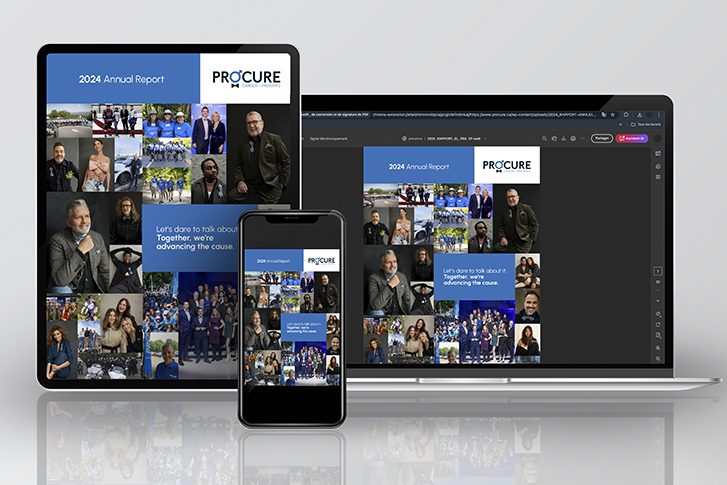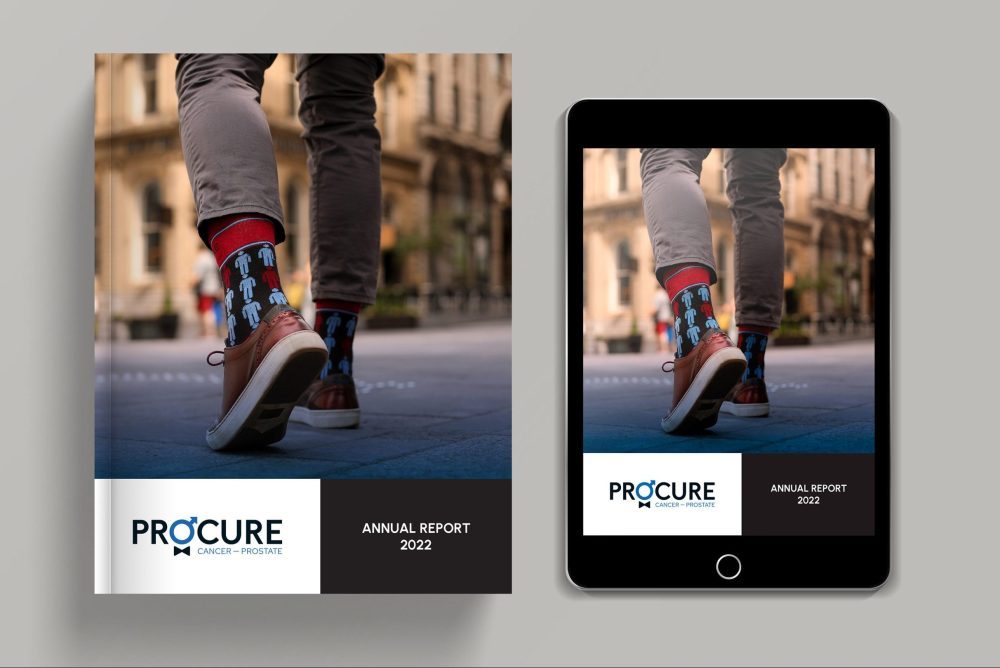Annual reports
- What we do
- Annual reports
- Annual Reports

Annual reports
Annual reports
The impact of your donations
We want to express our gratitude to our donors, our ambassadors, our volunteers, our employees and our loyal business partners, and to all those who support us year after year. Together we are stronger. Together, we can move things forward. That is why we would like to thank you today for your active involvement and your loyalty to the cause.
Where does the money come from?
(2023 data)

Where does your donation go?
(2023 data)
PROCURE is an organization that depends on the generosity of its donors to accomplish its mission. This is why we have the responsibility to see to sound financial management, the judicious use of sums, transparency, and long-term profitability. You can therefore be assured that your donation has a concrete impact on people affected by prostate cancer.
PROCURE makes every effort to reduce its administrative costs to keep them at a maximum of 10%. For the 2023 fiscal year, PROCURE minimized its administrative cost to only
5%. That means that at least $0.95 of every dollar donated directly supports the fight against prostate cancer.
2024 ANNUAL REPORT
2023 ANNUAL REPORT
2022 ANNUAL REPORT
2021 ANNUAL REPORT
2020 ANNUAL REPORT (FRENCH ONLY)
2019 ANNUAL REPORT
2018 ANNUAL REPORT (FRENCH ONLY)
2017 ANNUAL REPORT
2016 ANNUAL REPORT
2015 ANNUAL REPORT
2014 ANNUAL REPORT
2013 ANNUAL REPORT
Additional Information - Prostate cancer

Is prostate cancer hereditary?
Understanding the hereditary and genetic aspects of this disease can provide valuable information to both individuals affected and their families.

Genetics and prostate cancer
Do you have a family history of cancer? Your doctor might recommend genetic screening.

Symptoms, risk and screening
Are you over 50 or experiencing urinary problems? Discover why early screening for prostate diseases is important.

From prostate to screening
Learn about the role of your prostate, related diseases, symptoms to watch out for and risk factors.

Genetic predisposition to prostate cancer
Although rare, some hereditary genetic mutations can increase your risk of prostate cancer.

Do you have a curved penis?
Is your penis curved? Does it curve to the left, right, upward, or downward? You have a curved penis and you or your partner want to know why?

Can I prevent BRCA-related prostate cancer?
How to prevent BRCA-related prostate cancer? Can I have a radical prostatectomy or a proactive treatment to prevent prostate cancer?

What is a genetic mutation?
Do you have a significant family history of cancer? Is there a link between prostate cancer and a genetic mutation?

My balls hurt!
While sore balls are a common experience and usually no cause for concern, it’s important to familiarise yourself with symptoms in case it’s a sign of something serious.

I feel a heaviness in my underwear
I feel a heaviness in my underwear and I know it’s not normal… And sure enough, you notice your balls are much bigger than usual.

What women should know about prostate cancer
As a woman, you might think that prostate cancer is not your concern because you don’t have a prostate. However, prostate cancer is the most common cancer in men.

Why a health check?
The short answer to this question is to assess your health. This is the starting point for a health check. Could we be in the presence of potential undetected diseases?

10 signs that encourage you to see a doctor
There are many reasons why men will be referred to a specialist, and if you experience any of the following symptoms you should see a family doctor. Here are 10 signs that encourage you to consult. You should also know that unless you go to a private clinic, you cannot consult a specialist directly, such as […]

From your prostate to screening in 5 points
From your prostate to screening in 5 points. Gentlemen, are you over 50 years old, or have you been having urinary problems for some time now? Several diseases can affect your prostate, and it’s important to detect them early. Let’s take a closer look. The size of a walnut, the prostate is located just below […]
Sources and references
Last medical and editorial review: April 2024. See our web page validation committee and our collaborators by clicking here.












